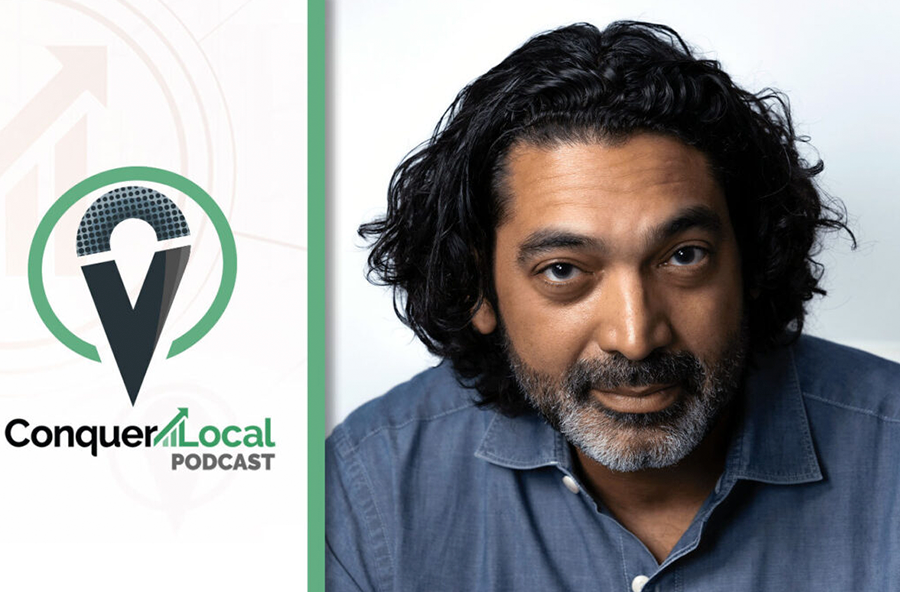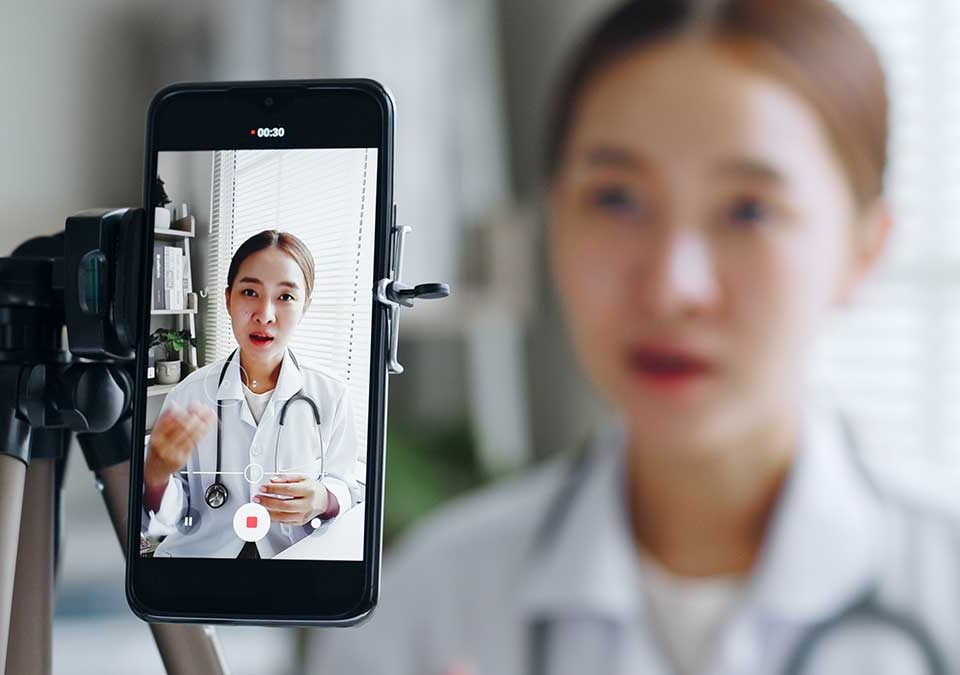
Creating the Right Advertising Strategy for Your CBD Brand
October 26, 2022
Why It’s Important to Build Your Influencer/Personal Brand
November 28, 2022Integrating Creative Design to your Brand
Today’s episode of the Conquer Local Podcast has a bit of a twist – What if you could incorporate Creative Design into your branding? Join George Leith in welcoming Fritz Colinet, a creative director who has been in the industry since 2001.
Fritz is the creative force behind Retna Media and has worked for over 25 years as a creative director, designer, and brand builder. His skills paved the way for opportunities to be the creative mind behind the rebranding of major brands such as Lady Foot Locker, Houston Open, Impact! Partners Financial, The Astorian, FullyRaw Kristina, and the Houston Dynamo.
Today, Fritz leads a full-service branding and marketing agency, Retna Media, based in Houston where he has managed over 200 strategic marketing campaigns. Since 2005, Retna Media has built brands from blue-chip companies to small businesses in diverse industries. This unconventional advertising agency uses strategic communication principles to analyze, target, and create campaigns with unrivaled results.
Conquer Local is presented by Vendasta. We have proudly served 5.5+ million local businesses through 60,000+ channel partners, agencies, and enterprise-level organizations. Learn more about Vendasta, and we can help your organization or learn more about Vendasta’s Affiliate Program and how our listeners (like yourself) make up to $10,000 off referrals.
Are you an entrepreneur, salesperson, or marketer? Then, keep the learning going in the Conquer Local Academy.
Introduction
George: This is the “Conquer Local” podcast, a show about billion-dollar sales leaders, marketers leading local economic growth, and entrepreneurs that have created their dream organizations. They wanna share their secrets, giving you the distilled version of their extraordinary feats. Our hope is with the tangible takeaways from each episode, you can rewire, rework, and reimagine your business. I’m George Leith. On this episode, we welcome Fritz Colinet. Fritz has been a creative director since 2001, over a 20-year career. He launched Retna Media in 2005. It’s a digital branding and marketing company based in Houston, Texas, working with startups, ThinkTech, FinTech, and small and medium-sized businesses. And he successfully managed over 200 strategic marketing campaigns, including the Houston Open, Houston Dynamo, Maker’s Mark Bourbon, and many more. Get Ready Conquerors for Fritz Colinet, coming up next on this week’s episode of the “Conquer Local” Podcast.
George: Well, joining us is the founder and CEO of Retna Media, Fritz Colinet. Fritz, how are things in Houston today?
Fritz: It’s fantastic, no complaints. The weather’s great
Geroge: it’s hot, probably, right?
Fritz: Oh, yeah. Like we like to say, there’s two seasons in Texas, hot and hotter.
Geroge: Well, we appreciate you joining us, and as I mentioned in the intro, you’re a lifelong marketer and you’ve been doing this for quite some time over 20 years. And when you launched Retna Media in 2005, you really were focused on that digital branding and marketing. what have you noticed has changed since 2005 to today? I’m sure there’s a lot, but what would be some of the biggest things you’ve noticed that has changed in marketing?
Fritz: One of the biggest changes in marketing is branding. Branding, right now the average person talks about building their brand, right? So where in the past we’re talking about marketing and sales now we’re focusing on branding, right? And then that brand is really pushing everything else. People buy brands, they do not buy products.
Geroge: Couldn’t agree more. I couldn’t agree more with that. You know, Fritz, one of the things that I noticed when I was reading through your bio and prepping for the episode, you and I are kindred spirits because I spent some time over the last few years advising startups through an incubator program here in our home market. And I noticed that’s one of your passions that you like to work with a lot of startups, small and medium businesses, you’re also connected to accelerator and incubator programs, of that work what would be some advice that you have for startups, for our audience, the people that are starting a brand new business and maybe some pearls of wisdom from Fritz?
Fritz: Well, I love working with startups and small businesses because it’s a clean slate, right? The one thing that I would always tell startups or small businesses know who you’re targeting, what their likes, what their dislikes. Understand who your audience is, right? What type of problem are you trying to solve for them, right? A lot of times we just go out in the wild and we just start marketing our product and not understanding who we’re targeting, what their likes, what their dislikes, number one. Number two, have a plan of action, right? Have your goal, have your strategy. You can always change your strategy, but your goal is still the same, focus on your goal. And remember that if your strategy is not working, pivot, right? That’s the great thing about this digital age right now, you’re able to pivot on a dime without too much cost against it, right? Everything is just zeros and ones, if it’s not working, change it, right? So fall forward and fall fast and get up.
Geroge: I find that having that mindset is something though that business folks need to either discover or to work on that muscle to develop it, where it’s like, it’s okay to make a change.
Fritz: You know what? It’s okay to make a change, and it’s okay to fail, right? I prefer working with clients who failed and understand that hustle mentality, that grit that pushes them a little bit further because they understand that feeling of what is like not to work, right? That failure, right? So now we’ve gotten over that failure. Now let’s just win, right?
George: Yeah, and I’d love to hear from you in your experience, but I’ve found that being transparent with that audience and saying, we’re gonna figure it out. Here’s where we’re going to get to as our goal, and we’re not quite sure whether all these tactics are gonna work when we deploy them, but we’re gonna check in on a regular basis and give you an update, do you agree with that type of an approach?
Fritz: No, you know what? I 100% agree with being authentic, and I 100% agree with letting your client know where you’re at in the process, right? This is the great thing that human beings will forgive you, right? If you fail, or if you haven’t achieved that metric, they’ll say, “Hey, you’ve tried, let’s kind of pivot, and let’s pivot together.” It’s just the data.
George: When you mentioned about having that action plan, I wanna unpack that a little bit more. I’m finding that young sellers are really quick to run the commercial that they’ve been given to pitch the product. You kind of talked about it. Know who you’re targeting, understand the problems or opportunities that they’re trying to capture. But having that mutually agreed to action plan, rather than just pitching all the time, sitting down with the customer and saying, Here’s what I heard from you. Here’s what I understand to be your desired goal. Here’s what we discussed, as might be some ways that we can get there. Like having that mutual action plan seems to be a really exciting silver bullet that will help get more positive outcomes in my opinion.
Fritz: Understanding what’s your goal, and then creating that plan. What is the first step, right? Who’s the target audience? What are their likes? What are their dislikes? What are we trying to achieve with this product, right? Where can this product be sold, right? What problem are we solving? Creating that action plan is extremely important. There’s no silver bullet for any strategy, right? But what there is, is a can-do attitude, right? You have a plan, go with the plan. If it’s not working, pivot, but make sure you have the metrics to understand where you’re going.
George: No, I couldn’t agree more. So on those 200 strategic marketing campaigns, you are working in 200 campaigns. Tell us about some of the ones that really jump out, the one that I’m really interested in is the Copenhagen Project.
Fritz: Well, Copenhagen is great. It was a great project to work on because it’s smokeless tobacco, right? So the great thing is that we were able to introduce a new way of getting your tobacco satisfaction, originally what happened was a lot of the campaigns were an individual just by themselves in the farm on a ranch, right? And in reality, we are a communal society. So we like to interact with each other, Let’s put ’em in an environment. That’s who we are as human beings. So let’s kind of capture a slice of life. And that’s what’s really great if you’re able to capture a slice of life for your product, right? You’re putting that person in that environment, they wanna be part of that environment. So let’s tell that story. Let’s be tongue-in-cheek about it. Let’s invite ’em in, right? So the great thing about building that campaign is we had the opportunity to create something that was totally different. Something different that they weren’t used to and the customer wanted, but they weren’t used to seeing it, right? So what we gave the customer is a slice of life, a slice of the environment. And we had Ty Murray, King of the Cowboys as the spokesperson, right? So he’s an eight-time world champion, rodeo star, so bull rider and we went to this great ranch, it was about 200 acres Gentleman’s ranch, right? And it wasn’t hard to get a shot there ’cause it was just pristine. But the strategy and what time of day are we gonna shoot? What’s the action? What do we wanna say with this piece of photography? And that’s really important. When you’re shooting photography, what are you trying to say with that picture, right? What is the end user interpreting, right? So you’re putting yourself in the shoes of the end-user and the multiple personas that could be your client base, right? or with any campaigns, there’s challenges. It’s how you’re able to overcome those challenges that separates you from the guys who can do good and the guys who can do great.
George: Well, I’m sure that you could tell us stories for hours over your career as a creative director and as we mentioned off the top, you’ve been managing campaigns for the Houston Open, Houston Dynamo, Makers Mark, and many more. In this campaign for my teenage habit that I don’t like to admit, Copenhagen, you also were able to include some diversity and inclusion into it by opening up that audience. I’d love to hear about that.
Fritz: Right, so it was actually one of the first time that we actually shot women inside the campaign. And also a Latin female as well. So again, we’re just shooting a slice of life, right? And your environment is just so diverse. So showcase that, showcase the reality, the authenticity of the campaign, right? So there’s a lot of clients that we work with that we explain to them and show them, hey, let’s open it up. We understand that this is your audience who you’re focusing on right now, but these are the challenges that they’re having. Let’s address those challenges. Let’s give them a solution and let’s create a campaign around that that delivers that solution for them. We really want to create evangelists of your product or service and this is how we’re gonna do it.
George: Yeah, I love that. Fritz, it’s pretty obvious that you have a whatever it takes attitude and I think it’s impressive that you can maintain a 100% client retention rate. And I’d love to get you to unpack how that’s been possible. How you’ve been able to keep that 100% client retention rate?
Fritz: I always say you gotta go above and beyond, right? The client’s gonna ask you for something that they want, right? And a lot of times, young agencies or young designers or young creatives, they fall into this category of taking orders from the client, right? They’ve hired you as an expert. You’re supposed to give them your professional opinion. You’re supposed to give them something that is gonna wow them, that’s gonna change their perspective, that’s gonna help them go into the next decade, right? So if you’re only taking orders, try sometimes to give them something that you believe is the right direction and talk about that and sell that because you’re gonna love what you’re gonna be doing instead of just what the client wants you to do.
George: Hey, Fritz, can I ask some questions around that? I think that’s fascinating. So what you’re saying is to put your own spin on the strategy that you’re suggesting so it matches exactly what the client is trying to accomplish. Is that where you’re going with there?
Fritz: Exactly, so you have the strategy of the campaign or the product or service, right? And sometimes the client wants to see whatever, right? They wanna see how they envision it. And sometimes we fall into this routine of let’s just do what the client wants, right? As a young agency. But they didn’t hire you to do what they wanted, they hired you to build their brand, right? Because if they just hired you to do what they wanted, then they would just do it internally, right? So you have to position yourself as an expert, you have to figure that out that each client is different. I’ve been lucky enough that the clients that I work with and my history speaks for itself. So when I talk to them and I’m not only talking to them about creative and strategy, I’m also talking to ’em about their business and how is it gonna affect their business, right? So we can do option A and this is the outcome, this is the perceived outcome. We can do option B and this is what’s the outcome is gonna be, right? So I present those both options and together we make a decision, but nine outta 10 times, it’s the option that I’m suggesting.
George: So the reason why I wanted to interrogate that a little bit more is we, on past episodes of the show, we have a lot of folks asking questions around how do I get to a scalable solution? What happens when I sell 30 of these customers or 50 or 100 of these customers? And I wanted to get your opinion on this ’cause you’ve been doing this for a long time, a lot of the tactics and underneath the strategy is very similar, but putting a layer on it that the customer can actually see themselves achieving their goals, even though that there is some repeatability to what’s being delivered. So then it’s not just a one-off every time, has that been your experience with your type of customer?
Fritz: So when you’re building out the strategy, every client has a goal of increasing awareness, having more sales, or driving more traffic to their particular website or their landing page. Now if that’s the goal, what’s the secondary goal? We have to ask ourselves, why do you want more traffic, right? Oh, I want more traffic so I can generate more sales. Why do you want more sales? I want more sales so I can purchase more product and I can hire a larger staff. Okay, so at the end of the day, you wanna purchase more product and hire more staff. Okay, cool, so now you know that it’s not just one component. You have strategically that there’s three other items that the client wants. They just only revealed one portion of it with you. So if you’re not asking the right questions, you’re not gonna get the answers you want.
George: And I’m assuming, but we all know what happens when you assume. So I wanna make sure I’m right on this. By having those secondary reasons, you will probably get to some sort of an economic benefit that you can then leverage –
Fritz: Of course
George: Throughout the relationship.
Fritz: Of course, so if a client comes to you and say they just want a brochure, well, that’s a one-off, right? So why do they want a brochure, right? Okay, so they tell you why now there’s a secondary option, right? So it’s gonna generate more revenue for you. And if you deliver on their promise, on your promise, the brochure, okay, so how are they gonna distribute their brochure? Is it internal? Is it external? Are you gonna do activation? So you start asking all these questions and now it just went from brochure to activation, a mailer, right? Now if it’s a mailer, you’re gonna need a campaign, right? ‘Cause you know it’s not gonna happen from a one-time mailer. So you’re identifying what are the needs of the client to yield the results that they’re expecting.
George: No, it makes a lot of sense to be able to get those, and I’m assuming again, that you’re gonna expand the relationship with the customer by asking those secondary questions.
Fritz: Of course, asking those secondary questions, you’re gonna get the response that they want because they’re looking for that solution, they just haven’t revealed it to you. That’s it.
George: Fritz, what advice would you give our listeners that are looking to get into the creative design space? Because why I loved having you on the show is we don’t really talk to a lot of creative designers. We talk to more people that are more around digital strategy and the products and the tools. Whereas you mentioned off the top, you were trying to expand the audience of Copenhagen, and part of that was getting a more diverse audience into the commercial shoot. So as we have our audience listening to this show and they’re like, wow, this stuff that Fritz is doing sounds pretty cool because I think it applies to all sorts of customers, not just large brands like Copenhagen, right down to small businesses. They need to be thinking more about their creativity that they put into their marketing, in my opinion.
Fritz: I’m working with this one client in an incubator program called Div Inc here in Houston they’re called Screen Skins, right? And the technology is fantastic. It’s a screen protector, but they’re able to put the team logo for your NFL team. Let’s say it’s the Texans, the Houston Texans, right? Or the New York Giants and once the phone is on, the logo disappears, it’s invisible. But when the phone is off, you can see your logo. So you’re able to be a fan all day and show your pride and your passion for your team throughout the day because you have your phone with you all day. So it’s a constant reminder. So all of those impressions are fantastic. So we created the new brand, we’re building the new website. So they came to us with, hey, we just need, a new brand identity. Okay, well what do you need? You need a new brand identity. How are you gonna launch that? Well, we’re thinking about doing a website, Okay, we have to do a website, What about all the marketing… Are you doing presentations? We have to do all your presentations. So we built the brand, the brand standards, and now we expanded all the needs that they’re gonna need to execute, go to market strategy.
George: Oh, I love that sounds like an exciting project.
Fritz: Oh, it’s amazing, right? So they penned a deal with the NFL. They’re in talks with two other large companies, global companies, and the technology is fantastic, right? So if I’m able to have my logo on my phone of the team that I’m passionate about and it doesn’t interrupt my viewing screen when it’s on, how brilliant is that?
George: Yeah, that’s brilliant, I love it. Well, Fritz, I’m sure that we could talk for hours, but I really appreciate you unpacking a few of these items for our audience and it was great meeting you, and thank you very much for your partnership, and congratulations on all your success.
Fritz: Thank you for your time, I appreciate it very much.
George: I got one last question, Fritz, I’m not gonna let you off that easily.
Fritz: Okay.
George: You’ve been doing marketing for quite some time. As you look forward in your crystal ball into the next five years, what are some things that we’re gonna see when it comes to marketing and creative design in your opinion?
Fritz: You’re gonna see a lot of AI, a lot of meta, you’re gonna see holograms kind of take over and it’s gonna feel futuristic, but it’s happening right now. Right? So every aspect of your waking day is gonna be branded. And we don’t realize that how much everything is engineered in our life and this is one thing I always say to designers and creatives you have the most amazing job. You can control how people perceive anything. Whether it feels luxurious, whether it has a sporty feel, whether it feels like it’s lesser than, it’s greater than, right? It’s masculine, feminine. You control that as a designer, as a creative. Not too many careers can do that, but your career can.
George: Yeah, it is amazing time. That is for sure, well, thanks for that look into Fritz’s crystal ball, and we really appreciate you having you on the “Conquer Local” podcast.
Fritz: Thank you, I appreciate it. everything, it was a great call.
Conclusion
George: Well, I love talking to creative directors because one of the things that I think gets missed sometimes when we’re talking about strategy and tactics and technology in digital marketing, you’ve gotta have a great message and you have to bring that message in a creative manner. I love what Fritz was saying about startups being a clean slate. It gives you the opportunity to start from scratch, but every day is an opportunity to start again. And knowing exactly who you’re targeting and what problems they’re trying to solve, or what opportunities they’re trying to capture is paramount in any marketing campaign. Getting down to those basics of what you need to put into a marketing campaign to be successful from a creative or from a message standpoint is something that we always need to be thinking about. And then, of course, we need to use technology tactics and digital components to make those items work properly here in 2022. But I love the fact that we talked a lot about creativity and the message around how they expanded the market for Copenhagen, which is that stuff that you put under your lip, and taking it so that it’s not just for cowboys was a pretty cool story as well. So we thank Fritz for joining us all the way from Houston to rejuvenate our creativity and talking about creative design and branding. If you wanna continue this conversation, check out episode 114 from Dennis Yu and episode 501, “Staying Human in the Age of Data” from Rishad Tobaccowala. Please subscribe and leave us a review. And thanks for joining us this week on the “Conquer Local” podcast. My name is George Leith, I’ll see you when I see you.





